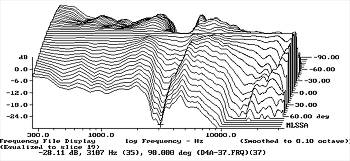Has anyone heard some of his speakers?
Raises hand. I have, and I now own 3 pair of Dunlavy's, the most recent showing up a little over a week ago.
It started by going to look at what was supposed to be a pair of SC-IV/A about 250 miles East of me near Chicago. They weren't /A's, they were low serial number original IVs, and they had sun-fading and too many nicks and scratches, so I passed. I was bummed out the entire drive back home.
The same day, after I got home from Chicago area, I saw a pair of SC-IIIs on FB marketplace 100 miles west of me for a really good price, but it took a few weeks for our schedules to align so I could listen to them. I finally got a chance to go to his house to hear them, and they sounded good, but I knew his room and placement left a lot to be desired, but I bought them anyway. Once I got them setup I was really impressed with what I was hearing. The longer I listened to them the more I loved what I was hearing, and completely different than my B&W Matrix 802 S3 speakers I've owned since 2001. The B&W 802 S3s always felt a little disconnected between the drivers for some reason. The imaging was awesome, but they always seemed bright and the bass didn't blend with the mids/tweets as great as I thought it should. The SC-III aren't bright, and almost seemed laid-back by comparison. They're not laid-back at all, they are just smooth as butter, and all of the drivers blend together seamlessly.
About 6 weeks after I got the SC-IIIs, a pair of beautiful SC-IVs showed up on Audiogon 300 miles south of me in Fenton, MO. The guy actually had two pairs he was selling, one pair early serial numbers and the others in the mid-800 range, so very late models. I ended up buying the high serial number pair sight-unseen because another guy had his eyes on them too and I didn't want to miss out. I drove down the next day to pick them up and had them in the house and setup that night.
The SC-IVs are nothing short of incredible IMO. They do everything right, and nothing wrong. Imaging is amazing when positioned properly, almost like a giant pair of headphones. Their ability to dig out little details on recordings I've listened to most of my life is amazing. The bass is great, no real need for sub(s) unless you like LOTS of bass. The only real drawbacks are their physical size, and they're not the most attractive speakers ever designed. What's surprising/not surprising, is how similar the SC-IIIs and SC-IVs sound. The imaging might be just a tiny bit better on the IIIs, but the bottom couple octaves on the IVs is much better, reaching down where the IIIs couldn't begin to touch. I guess John used to do demo's where'd he switch between his line of speakers and have people try to pick out which pair was actually playing because they all sounded so similar.
I could have easily lived with the IIIs or IVs for many years, and told myself the only way I'd ever replace them is if I found a pair of SC-IV/As or SC-V for the right price. Sure enough, almost a year to the day after I got my SC-IVs home, a pair SC-Vs showed up on US Audio Mart for a price I couldn't pass up. I have yet to get them out of the crate, into the house and properly setup, but hope to have that rectified in the coming days. I've read many comments over the years that say John thought the SC-Vs were the best speakers he ever built, so I should be in for a treat once I get them in the house and properly setup.


